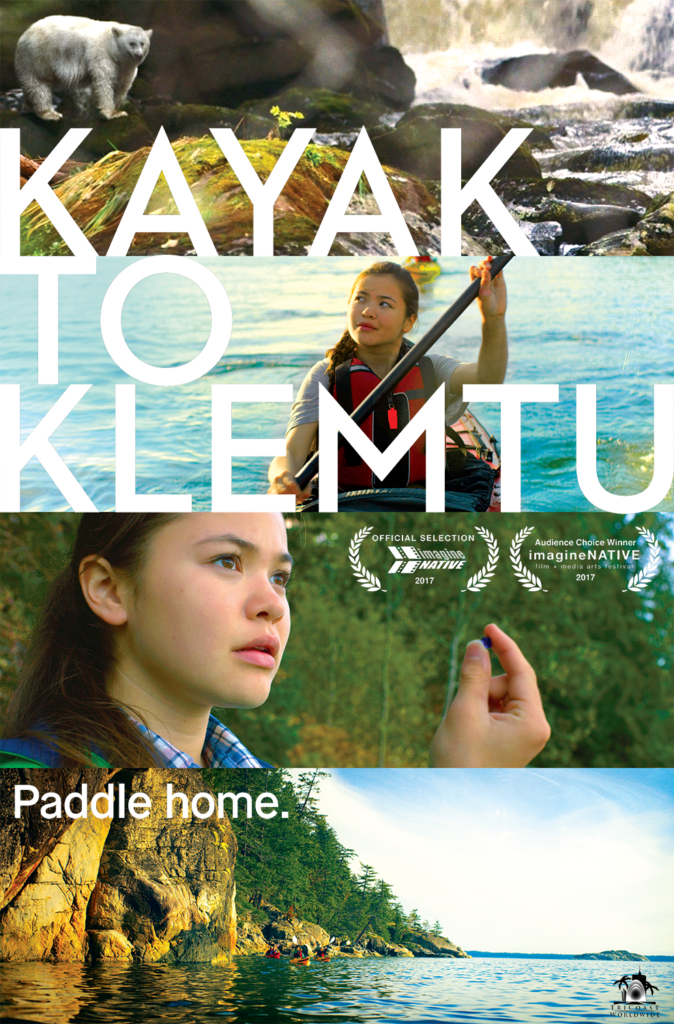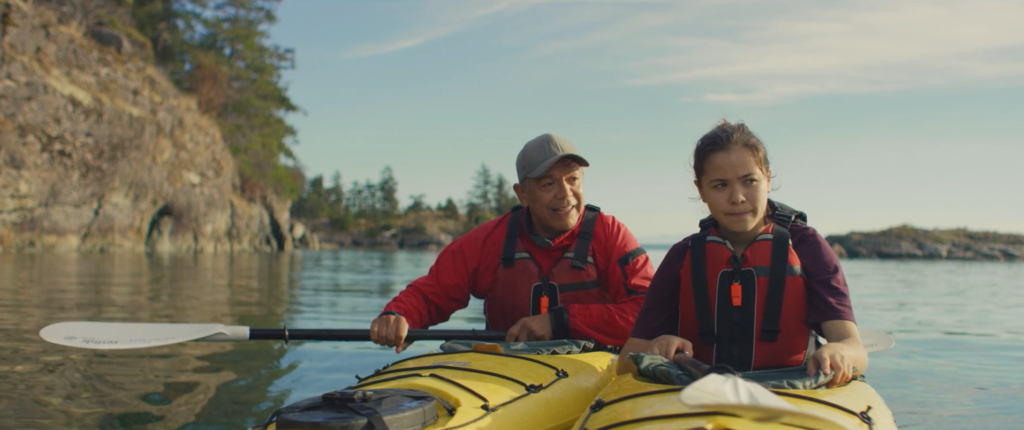Kayak to Klemtu is the colorful story of a young indigenous girl in British Columbia who is determined to honor her late uncle by paddling a kayak to her family’s ancestral home of Klemtu where she plans to attend a public hearing to speak out against oil tankers sailing through the Inside Passage. Filmed on location along the scenic coastline of British Columbia, Kayak to Klemtu provides viewers with a first hand look at life within the indigenous communities who have long called the region home.
I had the opportunity to speak with Director / Writer Zoe Hopkins about the movie to learn first hand about what it was like to film in such a pristine natural environment and discuss Kayak to Klemtu’s dominant themes of environment and family.
PX: The coastal region of British Columbia is a stunning location to set a movie. What was it like filming there and did the natural environment present any unique challenges?
ZH: We were so blessed everyday with incredible weather. I thought that dealing with rain in the Great Bear Rainforest would be an issue, but it was actually the opposite problem. It never rained once! We did have some scenes where we needed rain and we had to make our own and bring in rain machines for a day to film a stormy scene. It is sort of weird, but I guess that’s just the way things are going with climate change and that you can’t predict that it’s going to rain in the Great Bear Rainforest at any given time.
One of the other things us land-based people had to learn to deal with was the tides. We’re used to dealing with the sun and angles of the sun as filmmakers in terms of where we need to be and when. We had never before had to deal with tides and the shrinking and growing size of the beach as a result of the tide rising and falling. There were times when we had to hurry and clear our equipment off the beach because the tide was coming up so fast. When shooting some scenes we would start out with a beach that was three feet deep and by the time we were finished shooting the beach was 20 feet deep! That was a little bit tricky, but we managed!

PX: What was it like filming the on the water scenes?
ZH: Filming on the water was a challenge for sure. We were a really small crew, which sometimes was to our benefit and sometimes made things hard when we didn’t have enough people to be doing everything we needed to do. Filming on the water, that was when our tiny crew was really a good thing.
We had a few different scenarios when we were filming from various types of boats. One of the most used systems we had was all of us in a little skiff. The skipper and the sound person in the stern. Me and the camera assistant in the middle and the camera operator in the bow. We were just squished in there!
Sometimes we’d throw the cinematographer into the front seat of the tandem kayak and he’d be sitting backwards facing the person in the rear seat while they paddled. Other times we used a different type of boat that had a small upper deck and the cinematographer would be up on top.
There were also different ways we handled the kayaks. Sometimes we towed them. Sometimes we just held them in place and someone’s job would be to simply hold the kayak in place. We had to learn how to keep all the kayaks together in a line so no one was stacking up. All the actors got pretty good by the end about figuring out where they were in the shot, how far apart they needed to be, and were able to manage their kayaks well enough without us doing anything to help them.
PX: What was it like for the cast to go paddling? Were they familiar with kayaking or was this a new experience for them?
ZH: Kayaking was a new experience for all of the cast. We had one day of training in Vancouver area waters before we embarked on the whole production. The four actors and myself had some instruction. We went out for a paddle and actually got to see a cougar during the training day! The instructor told us there was a cougar at the shoreline the day before that had killed a seal and was there guarding its food. We paddled over to where it was and sure enough we got to see it, almost uncomfortably close. We just sat there and observed it for almost 10 minutes. We were so close and it was so beautiful! Of course, none of us had a camera, so we didn’t get a photo!
PX: Many people remember the Exxon Valdez disaster, but may not realize transporting hydrocarbons along the Pacific coast of North America remains a contentious issue. What was your goal in making Kayak to Kemtu?
ZH: The threat of super tankers passing through these waters was a real issue in recent years with the Northern Gateway Pipeline. With that project, there was a series of hearings held along the coast of B.C. in various communities. Bella Bella is my home community where I was born and there was a hearing held there. I was responsible for documenting all of the testimony. I listened to all of my people speak out against the project. It was just so unreal to me that we had to prove to the jury that this project was a terrible idea. That all these communities would have to try to prove that was so ludicrous to me I could not believe it. I stood behind the camera and I cried for three days listening to people fight to protect the water. That people would think we were just trying to protect our own area. But really, the ocean is a global concern, it’s not just a local concern.
With all of the hearings, all of the coastal people united and spoke out against the project. Other issues with the project [arose] such that it got shut down eventually. The Canadian government has since implemented a moratorium against supertankers on the Inside Passage, so we’ll never see those in the foreseeable future. However, there are so many things that people don’t know about; There are still vessels that can carry 100,000 liters of oil or fuel through those waters. It [the moratorium] only bans vessels that carry more than that. You can still carry a huge amount of toxic product through those waters. And it happens all the time. Boats travel from Seattle to Alaska weekly, whereas many people say they should be directed to the outside where people don’t live.
PX: In addition to environmental stewardship, family and a sense of maintaining a connection to your culture and heritage transcends the film. Why was it important for you to incorporate this component into the film?
ZH: I think that when you’re talking about the environment and the Inside Passage and the coast, you can’t talk about any of those things without talking about the indigenous people, the culture and the languages and the connection to the land and that place from an indigenous perspective. You can’t leave those people, my people, out. You can’t leave that whole community out of that topic. I feel that they are just so intrinsically tied.
This type of development and colonization of our coast is such a new part of our history and the history of that land. So we’re talking [roughly] 150 years of Canada’s existence and 500 years since contact, but it has been in more recent years that those more remote populations were contacted. But we have our own oral history that tell us we’ve been there forever. Science and archeological evidence dates our people being in that territory for more than 14,000 years. We’ve been stewards of that land and water for tens of thousands of years. It has only been in recent years where ruining it has been a concern.
So talking about that from a family perspective, I wanted to do that from an indigenous family perspective because I think indigenous culture, indigenous people, and the environment on that coast are tied.

PX: Where can people go to watch Kayak to Klemtu?
ZH: In the U.S., it is streaming on multiple platforms. Amazon Prime is one of them. I think it is also on Hulu and the other platforms. In Canada it’s on iTunes and the Google Play store and it’s coming to Crave later this month. We’re also selling DVDs online.
In a tragic turn of events which drove home Kayak to Klemtu’s environmental message, a tugboat ran aground outside of Bella Bella, Hopkin’s hometown where some of the filming took place, and leaked a 100,000 liters of fuel the day after Hopkins’ team finished production. The leaked fuel destroyed the natural environment, deprived residents of the ability to hunt, fish and gather food, and ruined a clam fishery for the foreseeable future. The disaster left 50 residents out of work and placed the small community in financial peril. It is an economic loss and a cultural loss as the community mourns the destroyed natural environment and loss of wildlife. Hopkins’ filmed a documentary, Impossible to Contain, chronicling the tragedy. The seven minute short film shot in a captivating 360 degree format is available on YouTube.
Kayak to Klemtu was Director Zoe Hopkins first feature film. In January she is planning to enter into pre-production on her next project titled, Running Home, a feature film set in Ontario.
Kayak to Klemtu trailer.
#Environment #Family #Interview #Movie #BritishColumbia
